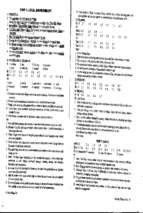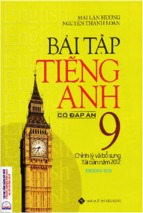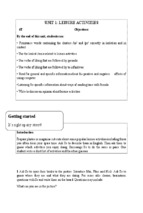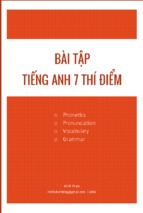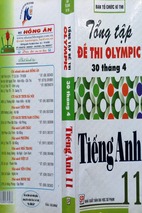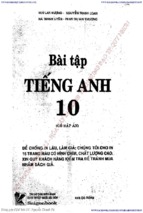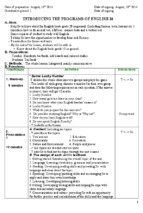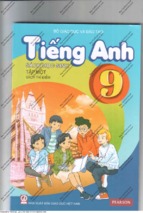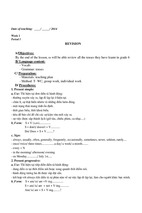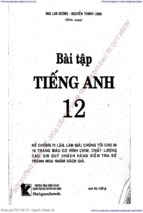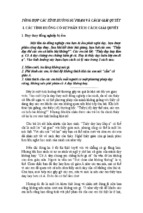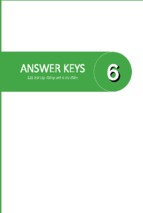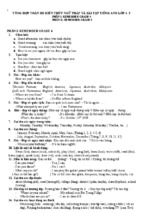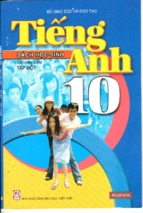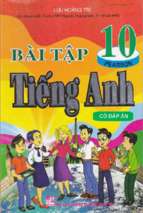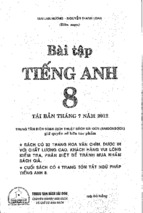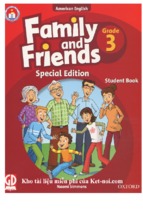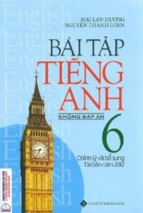Preparing date: 10th August, 2014
TiÕt sè: 01
PERIOD 1: REVISION ON TENSES AND WISH - SENTENCES
I. Objectives:
- After finishing the lesson, students should be able to use the tenses.
- Consolidate the usage of the present simple, past simple, future simple
- Develop writing skill.
II. Language content:
A. Vocabulary: unit 1(textbook- English 12)
B. Structures: Wish - sentences
III. Teaching aids and method:
- Teaching aids: textbook, workbook, exercisebooks…
- Method: Communicative approach.
IV. Procedures:
A. Presentation:
Teacher’s and students’ activities
- T introduces the tenses and
explains how to use them.
- T asks sts to look at the extra
board.
- T gives some examples.
- Sts listen and repeat.
- Sts copy the notes.
Content
I. Activities 1 :
A –Tenses:
1. Present simple tense: dieãn taû thoùi quen,
chaân lyù, hoat ñoäng thöôøng ngaøy, vaø ñöôïc duøng
keøm: Everyday, usually, after school never,
often, sometimes, always
+ KÑ: Sn, I + V.bare / Si + V-s/ es
+ PÑ: Sn + DO NOT+ V.Bare./ Si + DOES
NOT + V.Bare.
+ NV: DO / DOES + S + nV.Bare?
+ WH: WH + DO / DOES + S + V. Bare?
(Be) Am, is, are/
(Have) Have, has
a. Mr. Ba likes collecting stamps.
b. Ba has lunch at school.
2. Past simple tense: Haønh ñoäng xaûy ra ôû
QK xaùc ñònh roõ tgian, vaø ñöôïc duøng keøm:
Yesterday, ago, last… hoaëc moät thoùi quen, loaït
haønh ñoäng trong QK
+ KÑ: S + V_ed/ V2 (Baát qui taéc)
+ PÑ: S + DID NOT + V.Bare.
+ NV: DID + S + V.Bare?
+ WH: WH + DID + S + V.Bare?
Ex: VD: He was not there last year.
Ex: Did you buy souvenirs last vacation?
Page 1
–Yes, I bought a lot.
3. Future simple tense: Haønh ñoäng xaûy ra ôû
töông lai, vaø ñöôïc duøng keøm: Tomorrow,
tonight, soon, next,
S + WILL + V1
Ex: Where will you go tomorrow?
- I’ll be at home.
B – Wish sentence 2: Dieãn taû moät haønh ñoäng
hay söï vieäc khoâng thaät ôû hieän taïi.
S + WISH (ES) + S + WERE / V 2, V–ED /
DIDN’T V1
Ví duï:
B. Practice:
-T gives the task and asks sts to do it.
- T guides how to choose the best
option.
- Sts do the exercises (oral - written).
- Sts practice in groups.
- T gives feedback and keys.
- Some sts read aloud their answers.
- T gives remark and feedback.
-T gives the task and asks sts to do it.
- Sts do the exercises (oral - written).
-Sts practice in groups.
- T gives feedback and keys.
- Some sts read aloud their answers.
- Sts copy the key.
-T reviews how to write wish sentences.
- T gives the task and asks sts to do it.
- Sts do the exercises (oral - written).
- Sts practice in groups.
- T asks each student to do each
sentence on the board.
- T gives feedback and keys.
- Some sts read aloud their answers.
1. I wish I were a doctor.
2. I wish they could help us.
3. Nam wishes he did not come late.
II. Activity 2: Pretest
*Answers:
1. write
2. impressed 3. could lend
4. compulsory 5. were
III. Activity 3: Give the correct tenses of the
verbs in brackets:
1.
4.
7.
10.
13.
sets
will build
got
flow
didn’t talk
2.
5.
8.
11.
14.
rains
could
circles
will give / see
does...go/ goes
3. won
6. make
9. would write
12. met
15. came/
opened/ found
VI. Activity 4: Rewrite the sentences, using
“I wish…”
1. I wish I knew many people in the town.
2. I wish I could go to the party.
3. I wish I the weather were better than today.
4. I wish I weren’t so tall.
5. I wish I like to play soccer.
6. I wish I would meet her in June.
C. Consolidation:
- Remind tenses and wish sentences.
- Guide how to review Home revision: Simple past – present perfect
Page 2
- Learn your lesson at home.
- Do exercises (handouts).
th
Preparing date: 15 August, 2014
D. Homework:
TiÕt sè: 02
PERIOD 2: REVISION ON TENSES (continued)
I. Objectives: After finishing the lesson, students should be able to:
- Consolidate the usage of the present perfect, present progressive past progressive.
- Develop writing skill.
II. Language content:
A. Vocabulary: unit 2(textbook- English 12)
III. Teaching aids and method:
- Teaching aids: textbook, workbook, exercise books, students’ course…
- Method: Communicative approach.
IV. Procedures:
A. Warm up: The game: “Irregular verbs”
1
2
4
5
7
8
Simple form
Be
Past form
Past participle form
Been
Saw
Sell
Find
Eat
Did
- T asks sts to finish the left forms of the verbs in the table.
- Sts work in groups of five.
- The team, which has verbs that are more right, will win the game.
A. Presentation: Activity 1: Theory
Teacher’s and students’ activities
- T introduces the tenses and
explains how to use them.
- T asks sts to look at the extra
board.
- T gives some examples.
- Sts listen and repeat.
- Sts take notes.
Content
I. Revision on tenses:
1. Present perfect tense:
Dieãn taû haønh ñoäng xaûy ra töø QK keùo
daøi ñeán hieän taïi, haønh ñoäng vöøa môùi xaûy
ra/ soá laàn xaûy ra hoaëc haønh ñoäng xaûy ra
khoâng roõ thôøi gian/ chöa xaûy ra:
Since: töø khi / For: trong khoaûng/ So far = up
to now = up to present: (ñeán baây giôø), Just:
vöøa môùi, lately = recently: gaàn ñaây, once/
twice: moät/ hai laàn, Ever: ñaõ töøng, yet: chöa
Before: tröôùc ñaây already: roài
+ KÑ: Sn, I + HAVE + (ADV) + V3.
Si + HAS + (ADV) + V3.
+ PÑ: Sn, I + HAVE NOT/ HAS NOT (ADV) + V3.
+ NV: HAVE/ HAS + S + V3?
Page 3
+ WH: WH + HAVE/ HAS + S + V3?
- I have not met her since she moved to
London.
- He has just come back from his farm.
2. Present progressive tense: dieãn taû haønh
ñoäng xaûy ra luùc ñang noùi: Look! Nhìn kìa!
Listen! Haõy laéng nghe: Now = at present = at
the moment: baây giôø; haønh ñoäng ñaõ ñöôïc saép
xeáp cho töông lai (Next/ Tomorrow) , keøm vôùi
go / come / leave/ arrive.
+ KÑ: S + AM/ IS/ ARE + V- ing.
+ PÑ: S + AM/ IS/ ARE + NOT + V- ing.
+ NV: AM/ IS/ ARE + S + V- ing?
+ WH: WH + AM/ IS/ ARE + S + V-ing?
- Boû e: make making / come coming
- Gaáp ñoâi phuï aâm: stop stopping/ run
- Khoâng boû y: study studying/
Eg: What are you doing now? I’m reading a book.
- Is she watching TV at the moment?
– Yes, she is.
- I’m going to Dalat next week.
3. Past progressive tense: dieãn taû haønh
ñoäng xaûy ra taïi moät thôøi ñieåm trong QK.
hoaëc hai hay nhieàu haønh ñoäng song song:
Keøm vôùi When/ While
At this time yesterday: vaøo luùc naøy hoâm qua
At that time/ then: luùc ñoù.
+ KÑ: S + WAS/ WERE + V- ing. (I was)
+ PÑ: S + WASN’T/ WEREN’T + V- ing.
+ NV: WAS/ WERE + S + V-ing?
+ WH: WH + WAS/ WERE + S + V- ing?
- What were you doing then? I was sleeping at
10 P.M.
-When I came home, Hoa was watching
TV, my aunt was reading.
B. Practice: Activity 2
-T gives the task and asks sts to do it.
- T guides how to choose the best option.
- Sts do the exercises (oral - written).
- Sts practice in groups.
- T gives feedback and keys.
- Some sts read aloud their answers.
II. Activity 2: Give the correct tenses of the verbs
in brackets:
*Answers:
1.
3.
5.
7.
saw
is running
went / were having
think/ is knocking
2.
4.
6.
8.
was playing/ arrived
has taught/ graduated
has written/ has finished
were...doing/
Page 4
- T gives remark and feedback.
9. is crying
11. is coming
13. has just washed
15. lived
10. are preparing
12. isn’t takking
14. Have... seen
16. Have...ever seen/ have
did.....see/ saw
-T reviews how to write wish sentences. III. Activity 3: Rewrite the sentences:
1. I wish I they sometimes visited us.
- T gives the task and asks sts to do it.
2. I have worked for years.
- Sts do the exercises (oral - written).
3. We haven’t met for five years.
- Sts practice in groups.
4. I wish he invited us to the party.
- T asks each student to do each sentence
5. I wish I played football better.
on the board.
- T gives feedback and keys.
- Some sts read aloud their answers.
IV. Activity 4: Pretest
-T gives the task and asks sts to do it.
- T guides how to choose the best option *Answers:
1.
enjoying 2.
have lived 3.
- Sts do the exercises (oral - written).
4.
friendly
5.
correspond 6.
- Sts practice in groups.
ed
- T gives feedback and keys.
7.
national
8.
in
- Some sts read aloud their answers.
- T gives remark and feedback.
could
divided
C. Consolidation:
- Remind tenses.
- Guide how to review Home revision: Bare- infinitives – parallel
D. Homework:
- Learn your lesson at home.
---------------------------------------------------------------------------------------
Page 5
Preparing date: 19th August, 2014
Period 3: listening
TiÕt sè: 03
(Unit 1: HOMELIFE )
I. Objectives .
Help Sts to develop intensive listening skills for specific information related to
summer household chores , ordering ideas .
II. Teaching methods : individual , pair work , group work .
III. Materials : Textbook 12 (advanced), pictures , tape , CD .
IV. Procedures :
Time
Teacher's activities
sts' activities
I. Before you listen.
12'
- T asks Ss work in pairs to match each picture with - Work in pairs
the corresponding description . .
- T calls on some Ss to give their answers and write - Give the answer
them on the boards.
- T give the correct answer .
+ A : a walking toddler
+ B : feeding
- Read aloud
+ C : Vacuuming
+ D : cleaning
Pre-teaching vocabulary.
- Take note
- Before eliciting / Pre-teaching the new words, T
helps Ss to pronounce the words given in the book.
T may read aloud first or play the tape and ask Ss to
repeat in chorus and individually.
- T elicits I teaches some of these words or I and
those taken from the listening passage:
+ toddler
+ development process (n)
+ sliding glass door (n)
-Read through the
20'
statements .
+ cleanup project (n)
+ wipe (n)
- Listen to the tape .
- T may get Ss to make sentences with the words and
gives corrective feedback
II. While you listen.
Task a
Instruction: You are going to listen to a women’s
suggestions of summer domestic chores for kids, number
the ideas in ideas in order . The first one has been done for
you.
- Before Ss listen and do the task, T asks them to
Page 6
read through the statements. Then T instructs them
to use some strategies to do the task:
14’
1’
- T plays the tape once for Ss to do the task.
- Take note
- T asks for Ss' answers and writes them on the board.
- T plays the tape the second time for Ss to check
their answers.
- T asks Ss to work in groups of 4 to compare their answers
- T checks Ss' answers by calling on some Ss. T may
play the tape one more time for Ss to catch the
difficult phrases.
T gives the correct answers:
2.
Cleaning floors and carpets
- Work individually
3.
Sweeping and mopping floors
4.
Vacuuming
Work in group
5.
Cleaning spots on carpets
6.
Watering lawns and plants
7.
Cleaning windows and sliding glass doors
8. Spraying window cleaner
9. Wiping windows
III. After you listen
- T gets Ss to work individually to list all the things
that they do to help their parents .
- Ask sts to use the suggestions in part a,b .
- T can give them some help .
- Ask sts to present in a group of 4 or 5
- T can correct their presentation if necessary .
IV. Homework.
Ask students to prepare for the next lesson
Page 7
Preparing date: 25th August, 2014
writing: personal letters:
Letters of invitation
TiÕt sè: 04
1. Objectives:
By the end of the lesson, sts will be able to write a letter of invitation and other
forms to improve the vocabulary and grammar.
2. Teaching aids:
Textbook and handouts.
3. Procedure:
Time
7’
Steps
Warm - up
Work arrangement
Brainstorming:
- T. divides the class into groups of 4 to write down each Group work
part of an invitation letter:
+ Group 1: The event
+ Group 2: The place
+ Group 3: The time and date.
+ The invitation itself.
- T. collects their answers and then T. combines their
parts and calls on sts to read and checks.
Presentation
15’
- T. guides and and asks sts to prepare to write each part
Whole class
of a letter of invitation or a formal letter.
Group work
Part 1:
The Heading (the Address):
- T. uses handouts or a poster to explain the contents or
the form/ the rule.
This is in the top right-hand corner of the letter. First, write
the house number, then the street name. After this, write the
town under the street. For a letter to a person in another
country, write your country, too
Eg: (the sender)
113 Nguyen Du Street,
Mong Cai Town,
Quang Ninh Province,
Viet Nam,
The date: Under the address
25 th, October 2007
Eg: (The receicer):
Page 8
This is the top left-hand corner of the letter, under the address
of the sender a line ......
Part 2: The Greeting/Start with “Dear.....,” on the left,
about two lines under the date
Eg: Dear Mr. Brown,
Or Dear Sir,
Part 3: The Body / The first sentence: start a few space
in, like the first sentence of a new paragraph. Always
start with a capital letter.
Eg: I am writing to invite you to .....
Part 4: The Closing / the End
For business letters with “Dear Sir” or Dear Madam”, use
“Yourfaithfully,”. For friends, use “Yours sincerely,”or
“Yours, . Love, ....”and after that we put a comma.
Part 5: The Signature: Our Signature normally goes
under the Closing.
Here is a plan for a letter:
number- street
town (country)
date
number- street
town (country)
first name,
�
�
Dear........ �sur name,
� Sir,
�
Start .........................................................................................
.......................................................................................................
The Closing
first name
�
......name...... �
�full name
Practice
20’
- T. asks sts to work individually to write a letter
following the plan/the rule above.
- And then sts exchange their writing with their parters to
Individual work
correct and check.
- T. collects some writing to correct with the whole class & pair work and
whole class
and gives corrective comments
Homework
- T. guides sts to prepare test yourself a.
Whole class
3’
Page 9
Preparing date: 4th September, 214
TiÕt sè: 05
Grammar: reported speech with infinitives
1. Objectives:
Review grammar: Verb + (object) + to Verb _ ing: (I want (you) to do ect...)
2. Teaching aids:
Handouts, textbooks
3. Procedure:
A. Organisation:
11A3: ................
12A6: ................
12A8: .................
Warm - up
Brainstorming: Put the verb into the form, to ...or _ing.
Handouts:
1. When I’m tired, I enjoy ........ television. It’s relaxing. (watch).
2. It was a nice day, so we decided ........... for a walk. (go)
.....................................
Answers: 1. watching
2. to go
Grammar
a) Presentation.
- T. elicits and gives sentences to discuss:
Eg:
verb + to.....
or verb + object + to ....
* We expected to be late.
* We expected her to be late.
* Would you like to go now ?
* Would you like him to go by bus ?
..........................
- T. gives out the handouts to further practice the following verbs.
want
ask
help
would like
would hate
expect
beg
would love
would prefer
would dislike
Be careful with want. Do not say “want that .....”
* Do you want me to come early ? ( not “Do you want that I come early ?” )
Eg:
* Can you remind me to phone her ?
* Who told her not to write to me ?
These verbs have the structure verb + object + to .......
- T. gives the handouts to summarize the structure.
tell
Remind
force
teach
Page 10
order
Warn
invite
persuade
- T. uses the handouts for sts to further practice and summarize, comapre the
points
Handouts:
* I allowed him to use my car .
* I allowed driving to work
There are two possible structures after the verb:
advise
Encourage
allow
Permit
Note:
Make and let
Eg: - They make me study hard
- She lets him go out.
We say “make somebody do something...” “not to do something”)
b) Practice
- T. uses the handouts to practice these structures:
a) Complete these sentences so that the meaning is similar to the first sentence.
1. I was surprised that she came back late.
I didn’t expect __________ (her to come back late)
2. Don’t stop him doing what he wants.
Let _____(him do what he wants)
3. My father said I shouldn’t say anything to the strangers.
My father advised _____ (me not to say anything to the strangers)
b) Put the verb in the right form: - ing or infinitive (with or without to)
1. She doesn’t allow (smoke) ____ in the house smoking
2. Pele encouraged Ronaldo (take) _____ part in the World Cup 2002 to take
3. She wouldn’t let me (read) _____ this letter read
Homework
- T. summarizes the main teaching points.
- T. asks sts to prepare for new lesson.
* Comment:
Preparing date: 11th September, 2014
Unit 2: Cultural Diversity
TiÕt sè: 06
Speaking
Page 11
Objectives:
- By the end of the lesson, student are able to express compliments.
- By the end of the lesson, student are able to respond to compliments.
Skills:
- Speaking: making and responding to compliments
Teaching aids:
- Handouts, Textbooks (12 advanced)
Stages
Procedure
Game: ‘ Yes/ No Contest’
- Divide SS into two groups, A and B.
Before you - Tell each groups to choose 2 representatives as
contestants.
speak
- In turn, the contestans will go to the front of the
class and answer the questions made by the other
group. They must say ‘yes’ or ‘no’, nor nod or
shake their heads when they answer, but just give a
phrase in agreement or disagreement.
This is the example:
S1 : Are you a student?
S2: I am
S1: Do you like pop music?
S2: Very much./ Not very much. /I don’t think so.
Aims
- To raise interest,
to engage SS, and
to lead in to the
lesson
- Tell SS if they give a ‘nod’ or ‘shake’ or say ‘ yes’, or
‘no’, they lose the game.
- The contestant who can answer 10 questions without
breaking the rules wins the game.
- Ask SS if it is easy to answer questions without saying
‘yes’ or ‘no’, or without nodding or shaking their
heads.
- Transition: It’s not easy at all because it’s part of our
culture. But we can also learn about other cultures. The
cultural aspect we’ll learn and practise today is
compliments. How to make and prespond to a
compliment.
- Write on the board:
Unit 2 Cultural Diversity-Speaking
1. Giving models (Task a, p.27)
While
speak
- Put SS into pairs and ask them to act out the -To introduce the
you exchanges.
target language in
- Call on some close and open pairs to act out the ax context
changes.
- Ask SS which ones are more common in Vietnamese
cultures and which are common or acceptable in
Western cultures.
- Tell that polite in most Western cultures to say
‘thank-you’ in response to a compliment.
2. Introducing Useful Language
- Elicit from SS the expressions that may be use to
give compliments and those used to respond to
compliments.
- Introduce to SS the common structures used to
express compliments and some common example.
- Suggest some common expressions used to
respond to compliments.
Useful Expressions
Compliment:
o
How +adjective( S+ be) !
How beautiful( your dress is)!
o
What noun(S+be)!
- To provide
language input for
speaking activities
later
-To provide some
Page 12
What a nice hat( it is)!
o
Your parents must
o
Be proud of your …!
o
Amazin! You’ve made an excellent …!
Responses to compliments
o
Thank you.
o I’m glad you like it.
o It’s nice of you to say so.
Your compliment is
Activity 1: Life-like Situations (Task b, p.28)
- Arrange SS to work in pairs.
freer practice
-To provide a
- Ask SS to read the situations provided.
-Tell SS to play the roles and act out the conversations, meaningful
activity where SS
giving and responding to comliments.
After
speak
- Call on pair to act out their exchanges.
- Invite the class to give opinions and comments.
- Give feedback and comments.
you Activity 2: Persionalization
talk about
themselves
- Tell SS to look around the classroom, and make
compliments on their classmates, what they have or
what they have done.
- Tell SS to respond to their classmates’ compliments.
- Write down some prompts on the board and tell SS
they can give compliments on these things:
o Clothes: shirt, trousers, coat, scarf, …
o Hair style, hairpins, shose, …
o Scores, test results, project, …
- Give a model:
T: How nice your shose are!
S: Thank you.
- Call for volunteers to act out their exchanges.
- Invite SS to give comments on their friends’ work.
- Give feedback and comments: compliments or
-Sth to do at home
encouragement on what SS have done.
Language review
- Ask SS to revise the language used to express and to
respond to compliments.
Preparing date: 13th September, 2014
TiÕt sè: 07
REVISION ON PASSIVE VOICE
I. Objectives: After finishing the lesson, students should be able to:
- Consolidate the usage of passive voice.
- Develop writing skill.
II. Language content:
Exercises on passive forms of present simple, present past and modals.
III. Teaching aids and method:
- Teaching aids: textbook, workbook, exercise books, grammar books …
- Method: Communicative approach.
IV. Procedures:
A. Presentation:
Teacher’s and students’ activities
Content
Page 13
- T reviews grammar rules and I. Activities 1: Theory:
Tenses
Formation
takes some examples.
Present simple
S + Am / Is / Are + V3
- Sts listen and copy the rules.
Past simple
S + was / were + V3
Modals
S + modal+ be + V3
1. People don’t use this dictionary.
This dictionary isn’t used.
2. Someone gave Mary this present.
Mary was given this present.
3. They will organize a meeting.
A meeting will be organized.
B. Practice:
-
T asks sts to do the exercise.
Sts do the exercise.
Sts read their results.
T gives the feedback.
- T guides.
- Sts practice in pairs.
- Sts do the exercise individually.
- Sts write the answers on the board.
- Sts share the result with their partner.
- Sts read their sentences aloud.
- T gives remark and marks.
II. Activities 2: Pretest
*Answers:
1. national
4. did you
2. is used to
5. used to
3. so
6. feel
III. Activities 3: Change into passive voice:
1.
2.
3.
4.
5.
6.
7.
8.
9.
10.
11.
12.
13.
14.
15.
These products have to be tested.
This dictionary isn’t used very often.
Mary was given this hat an hour ago.
I was told me that our teacher was sick.
Our project must be finished on time.
A cure can be found for cancer in the future.
The old building ought to be knocked down.
The telephone was invented by Alexander Bell.
That play was written by Shakespeare.
French is spoken in France.
This exercise must be carefully done.
A meal isn’t cooked by in the kitchen by her mother.
Is the school the library visited by Nam
everyday?
The question wasn’t answered yesterday.
Was the living room decorated?
C. Consolidation:
- Remind tenses.
- Guide how to review Home revision: Full—infinitive structures.
D. Homework:
- Learn your lesson at home.
- Do exercises (handouts)
- Prepare for the next lesson.
Page 14
Preparing date: 17th September, 2014
TiÕt sè: 08
Writing: writing a letter of reply
1. Objectives:
By the end of the lesson:
- sts will able to understand the contents, vocabulary and structures of a reply letter.
2. Teaching aids:
Handouts, textbooks
3. Procedure:
A. Organisation:
12A3.....
12A6.......
12A8.......
B. New lesson:
Time
7’
Steps
Warmer
Work
arrangemen
t
Whole class
Page 15
15’
Handouts:
Match the greetings and endings. Which are formal?
1. Dear
a. Yours (Maria)
2. Dear Sir or Madam
b. Yours faithfully (Mark Geogre)
3. Darling Rosie
c. Love (Teddy)
4. Dear Mr. Baker
d. Lots of love (Bob Charton)
5. Dear David
e. Yours sincerely (William)
- Sts work and discuss in pairs.
- T. goes around the class to check and give help if necessary.
- T. gets feedback and correct with the whole class.
Answers:
* 1 - c, 2 - b (formal), 3 - d, 4 - e (formal), 5 - a.
- T. elicits and repeat the format of a letter of reply.
Writing
Pair work
Activity 1
and whole
class
- T. gives the handouts and explains how to complete.
- Pupils work and discuss in groups and choose the suitable
number to fill in gap so that sts can understand the way of
writing a formal letter of reply.
- In the meantime, T. goes around and checks.
Handouts:
Write the correct numbers of the following rules in the
correct boxes on the letter.
1
120 Ly Tu Trong St.
Quang Ninh Province.
22nd November 2007
20 Bach Dang St,
Ha Long City.
Dear Sir or Madam,
I have read the information about the English Speaking
Competition on your Language Centers Website. I am
interested in practising English with native speakers and I want
to get some information about the competition.
Could you please send me details of the competition, the
number of participants, entry procedures, venue, date and time?
Please provide me with your phone number and e-mail.
I look forward to hearing from you soon.
Yours truly,
Thu Anh
1. We write our own address in the top right hand corner.
2. We end with an expression like: “I look forward to....”
3. We write the receivers name and address on the left hand side.
4. We sign off with “Yours truly”
5. We write our name under the signature.
6. We don’t use short forms.
7. We write the date under our address.
8. We start the letter with “Dear... ,”
9. We use “Sir or Madam” if we don’t know the persons name.
- T. goes around the class and gives help if necessary.
- T. corrects and gives feedback.
Page 16
20’
Answers:
1 - 7 - 3 - 8 - 9 - 6 - 2 - 4 - 5.
Individual
Activity 2
work and
- T. gives the handouts for sts to further practice.
- sts work in groups / pairs to complete the suggestions and whole class
then compare.
Handouts:
Use the given words to make meaningful sentences which form a
letter.
Dear Sir,
1. I / read / information / Maths Contest / your school’s website.
2. I / be very interested / Maths / especially / mathematical
puzzles / I would like / have / information / contest .
3. You / please send / details / contest / include / place / time ?
4. Please / contact me / 0464 - 4975643
5. I / look forward / hear / you / soon.
Yours sincerely,
Thanh Nam.
Answer.
3’
Dear Sir,
I have read the information about the Maths Contest on your
school’s website. I am very interested in Maths, especially
mathematical puzzles and I would like to have some information
about the contest.
Could you please send me details of the contest, including the
place and time? Please contact me on the phone 0464 - 4975643
I look forward to hearing from you soon
Yours sincerely, Thanh Anh
Homework
- T. repeats the ways of writing a letter of reply: vocabulary,
structures, contents...
- T. asks sts to write a letter: You are working at the
Organising Committee for Maths Contest. Write Thanh Anh
a reply, basing on the letter above.
* Comments
Whole class
Page 17
Preparing date: 19th September, 2014
TiÕt sè: 09
REVISION ON REPORTED SPEECH
I. Aims
* By the end of the lesson, sts will be able to master the use of :
- Word combinations with home and house.
- Present simple expressing routine.
- Reported speech: statements and questions .
II. Materials
- Text books, colour chalk…..
IV. Procedure
Time
Teacher’ s activities
10’
Sts’ activities
I. Grammar.
* Present simple expressing routine .
- Ask sts to revise the use of present simple to express - Work in pairs
daily routine .
- T can help if they can’t revise correctly .
- Ask sts to make questions for these answers .
1.What time does she put dirty dishes in the sink and wash them?
2.What time does she do the laundry and hang up wet clothes?
3.What time does she take the baby to kindergarten?
4.What time does she mail letters?
5.What time does she shop for food?
6.What time does she prepare lunch?
7.What time does she take a nap?
8.What time does she pick up the baby?
9.What time does she prepare dinner?
- Ask and
answer
- Ask sts to work in pair to ask and answer the questions
in the text book .
- Use these questions to ask each other .
Eg: What time do you put dirty dishes in the sink and
wash them ?
20’
* Reported speech
T revises the way to change tenses,avd…into indirect speech -Take note
NÕu ®éng tõ giíi thiÖu ë th× hiÖn t¹i ®¬n, hiÖn t¹i hoµn
thµnh, or t¬ng lai ®¬n th× trong lêi trÝch dÉn ta chØ ®æi ®¹i tõ
(pronouns) or tÝnh tõ së h÷u sao cho thÝch hîp.
Ex. - The farmer says: “I hope it will rain tomorrow”
= The farmer says he hopes it will rain tomorrow.
Page 18
She has said: “I’m tired now”
= She has said she is tired now.
NÕu ®éng tõ trong mÖnh ®Ò chÝnh ë th× qu¸ khø ®¬n, th×
trong lêi trÝch dÉn ta ph¶i ®æi th×, c¸c tõ hoÆc côm tõ chØ thêi
gian, vÞ trÝ, ®¹i tõ … .
1. Simple present
->
Simple past
S + Vs,es + …
->
S + Ved + …
2. Present continuous
->
Past continuous
-Take note
S + am/is/are + Ving ->
S + was/were + Ving
3. Present perfect
->
Past perfect
S + have/has + done ->
S + had + done
4. Present perfect continuous -> Past perfect continuous
S + have/has + been + Ving -> S + had been +Ving
5. Simple past
->
Simple past/ past perfect
S + Ved + …
->
S + had + done + …
6. Past continuous
->
Past continuous/ Past perfect
cont S + was/were + Ving -> S + had been + Ving
7. Simple future
->
Future in the past
S + will + V + …
->
S + would + V + …
8. Future continuous
->
Future cont in the past
S + will + be +Ving ->S + would + be + Ving + …
Time:
+ Yesterday
- The previous day/ the day before
+ Five days ago
- Five days before/ earlier
+ Last + N
- The previous + N
+ Now
- Then
+ Today
- That day
+ Tonight
- That night
+ Tomorrow
->
- The next day/ the following day
+ Next week
->
- The next week/ the following week
+ The day before yesterday
-> - Two days before
+ The day after tomorrow
->
- Two days after
Place
+ Here
- There
+ There
- There
Demonstrative
+ This
- That
+ These
- Those
- Ask sts to report the interview .
- T give feedback and correct answer .
13’
First, the interviewer wanted to know how many children Mrs.
Green had. She said that she had two, a daughter and a son.
Then the interviewer asked about the conflicts between her
and her children. She said it was a long story. Her children
were always neglecting their domestic responsibilities and
arguing when being reminded.
Next, the interviewer wanted examples.
She let him know that she often battled with her daughter against
the latter's messy room or 'her irresponsibility for collecting and
disposing of the garbage can.
Finally, the interviewer wanted to know about the conflict with her
son. She complained that her son was worse than his sister. He
never helped her with household chores. He was always taking out
things and never returning them to their places.
II. Read and report.
- Ask sts to report
- T goes around to listen and takes notes of the typical errors -Work in pairs
- T calls on some Ss to read' the sentences again and provides
Page 19
corrective feedback.
Virginia said that she remembered when she had been
her daughter's age, she had had twice as much work to
do around the house. She wouldn't have dreamed of
blowing off the responsibility. And that today's kids had
too easy responsibility.
HOMEWORK
- Ask sts to revise what they have learned .
- Prepare for the next lesson
Page 20
- Xem thêm -

